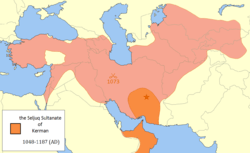Kerman Seljuk Sultanate
| Kerman Seljuk Sultanate قاوٙرْدیان یا آل قاوٙرد | |||||||||||
|---|---|---|---|---|---|---|---|---|---|---|---|
| 429 AH–552 AH | |||||||||||
 Flag
 Coat of arms
| |||||||||||
 | |||||||||||
| Status | Monarchy | ||||||||||
| Capital | Kerman | ||||||||||
| Capital-in-exile | Bam, Iran | ||||||||||
| Common languages | Farsi | ||||||||||
| Religion | Islam, Sunni | ||||||||||
| Government | Monarchy | ||||||||||
| Sultan | |||||||||||
| Historical era | middle age | ||||||||||
• Established | 429 AH | ||||||||||
• War with Great Seljuks (Kerj abudulaf) | 465 AH | ||||||||||
• Murdered of Iranshah of Kerman | 495 | ||||||||||
• Civil Wars | 562-572 | ||||||||||
• invasion of Ghuzz | 575 AH | ||||||||||
• Disestablished | 552 AH | ||||||||||
| Area | |||||||||||
| 465 AH | 433,389 km2 (167,332 sq mi) | ||||||||||
| 583 AH | 106,196 km2 (41,003 sq mi) | ||||||||||
| |||||||||||
| Today part of | |||||||||||
The Kerman Seljuk Sultanate (also known as Kerman sultanate Persian: سلجوقیان کرمان Saljūqiyān-i Kerman) was a Turko-Persian Sunni Muslim state, established in the parts of Kerman and Makran which had been conquered from the Buyid dynasty by the Seljuk Empire which was established by Seljuk Turks. The Sultanate of Kerman seceded from the Great Seljuk Empire under Qavurt[1] in 1048, following the Conquest of Kerman, with capitals first at Kerman and then at Bam and Jiroft.
Background
The Seljuq dynasty was a Turkish Sunni Muslim dynasty that established both the Seljuq Empire and Sultanate of Rum, which at their total height stretched from Anatolia through Persia. Qavurt was the son of Çağrı Bey, who was the grandson of Seljuk, the founder of the dynasty.[2] Qavurt’s brother Alp Arslan succeeded his uncle Tuğrul as the new sultan and Qavurt then the governor of Kirman (south Persia) waited for his turn.
Alp Arslan's will
Alp Arslan died in 1072. But before death he willed his throne to Malik Shah I, his second son. He also expressed his concern about possible throne struggles. The main contestants for the throne were his eldest son Ayaz and his brother Qavurt. As a compromise, he willed generous grants to Ayaz and Qavurt. He also willed Qavurt to marry his widow.
Qavurt's rebellion
Malik Shah was only 17 or 18 years of age when he ascended to throne. Although Ayaz presented no problem, he faced with the serious problem of Qavurt's rebellion.[3] His vizier Nizam al-Mulk was even more worried for he had become the de facto ruler of the empire during young Malik Shah’s reign. Although Qavurt had only a small army, Turkmen officiers in Malik Shah’s army tended to support Qavurt. So Malik Shah and Nizam al-Mulk added non Turkic regiments to Seljuk army. Artukids also supported Malik Shah. The clash was at a location known as Kerç kapı (or Kerec [4] ) close to Hamedan on 16 May 1073. Malik Shah was able to defeat Qavurt’s forces. Although Qavurt escaped, he was soon arrested. Initially Malik Shah was tolerant to his uncle. But Nizam al-Mulk convinced the young sultan to execute Qavurt. Nizam al-Mulk also executed Qavurt’s four sons.[5] Later he eliminated most of the Turkic commanders of the army whom he suspected to be Qavurt’s partisan.
Overthrow
The son of Bahram-Shah, Muhammad-Shah succeeded his uncle Turan-Shah to the throne of Kerman in 1183. By the time of his ascension Kerman had been overrun by bands of Ghuzz Turks. Their devastation of the province had made the city of Bardasir virtually uninhabitable, so Muhammad-Shah made Bam his capital. By 1186, however, Muhammad-Shah been unable to handle the Ghuzz, and he decided to abandon Bam and departed from Kerman. The Ghuzz chief Malik Dinar quickly seized control of Kerman in his place.[6]
Muhammad-Shah at first hoped to receive foreign assistance to reacquire Kerman, and traveled to Fars and Iraq requesting help. He also sought for aid from the Khwarezmshah Tekish. Eventually, however, he realized that he could get no assistance in recovering Kerman. He made his way to the Ghurid Empire and spent the remainder of his life in the service of the Ghurid sultans.[6]
| Seljuq-Beg | |||||||||||||||||||||||||||||||||||||||
| Mikail | |||||||||||||||||||||||||||||||||||||||
| Chaghri-Beg | |||||||||||||||||||||||||||||||||||||||
| Qavurt first shah | |||||||||||||||||||||||||||||||||||||||
| Turan-shah fourth shah | Sultan-shah Third shah | Kerman-shah second shah | |||||||||||||||||||||||||||||||||||||
| Iran-shah fifth shah | Arslan-shah sixth shah | ||||||||||||||||||||||||||||||||||||||
| Muhammad-shah seventh shah | |||||||||||||||||||||||||||||||||||||||
| Tuqrul-shah eighth shah | |||||||||||||||||||||||||||||||||||||||
| Turan-shah II eleventh shah | Bahram-shah ninth shah | Arslan-shah II tenth shah | |||||||||||||||||||||||||||||||||||||
| Muhammad-shah II last shah | |||||||||||||||||||||||||||||||||||||||
References
- ↑ Family tree of Seljuks
- ↑ Family tree of Seljuks
- ↑ Encyclopædia Britannica, Expo 70 ed. Vol 14, p. 699
- ↑ Sina Akşin-Ümit Hassan: Türkiye Tarihi 1 Vatan Kitap, 2009, ISBN 975-406-563-2, p.180
- ↑ Salim Koca: The Forces in the Determination of the Political Power in the Seljuk State (in Turkish)
- 1 2 Bosworth, p. 174
- Bosworth, C. E. (2004). The New Islamic Dynasties: a Chronological and Genealogical Manual
ISBN 0-7486-2137-7. Edinburgh University Press. templatestyles stripmarker in
|title=at position 68 (help)